Food Safety Management Report for Brasserie Restaurant: Analysis
VerifiedAdded on 2021/02/20
|14
|5409
|31
Report
AI Summary
This report provides a comprehensive overview of food safety management, focusing on the specific context of a new restaurant, Brasserie. The introduction highlights the importance of food safety and hygiene in the competitive food industry, emphasizing the need for adherence to legal norms to prevent foodborne illnesses. The report is structured into three tasks. Task 1 reviews controls to prevent food contaminants, emphasizing the importance of cleanliness, separate raw material storage, thorough cooking, and training. It also discusses physical and chemical contamination. Task 2 analyzes agents of food spoilage, including bacteria, yeast, molds, enzymes, and oxygen, and their impact on food quality. It also covers food preservation methods, differentiating between traditional methods like refrigeration, freezing, pasteurization, salting, sugaring, and modern techniques. Task 3 focuses on methods for safe food storage, including temperature control systems, and emphasizes the significance of personal hygiene, cleaning, disinfection, and pest control. It also justifies the need for hygienic design of premises and hygiene training. The report concludes by summarizing key findings and recommendations for ensuring food safety and quality at Brasserie.
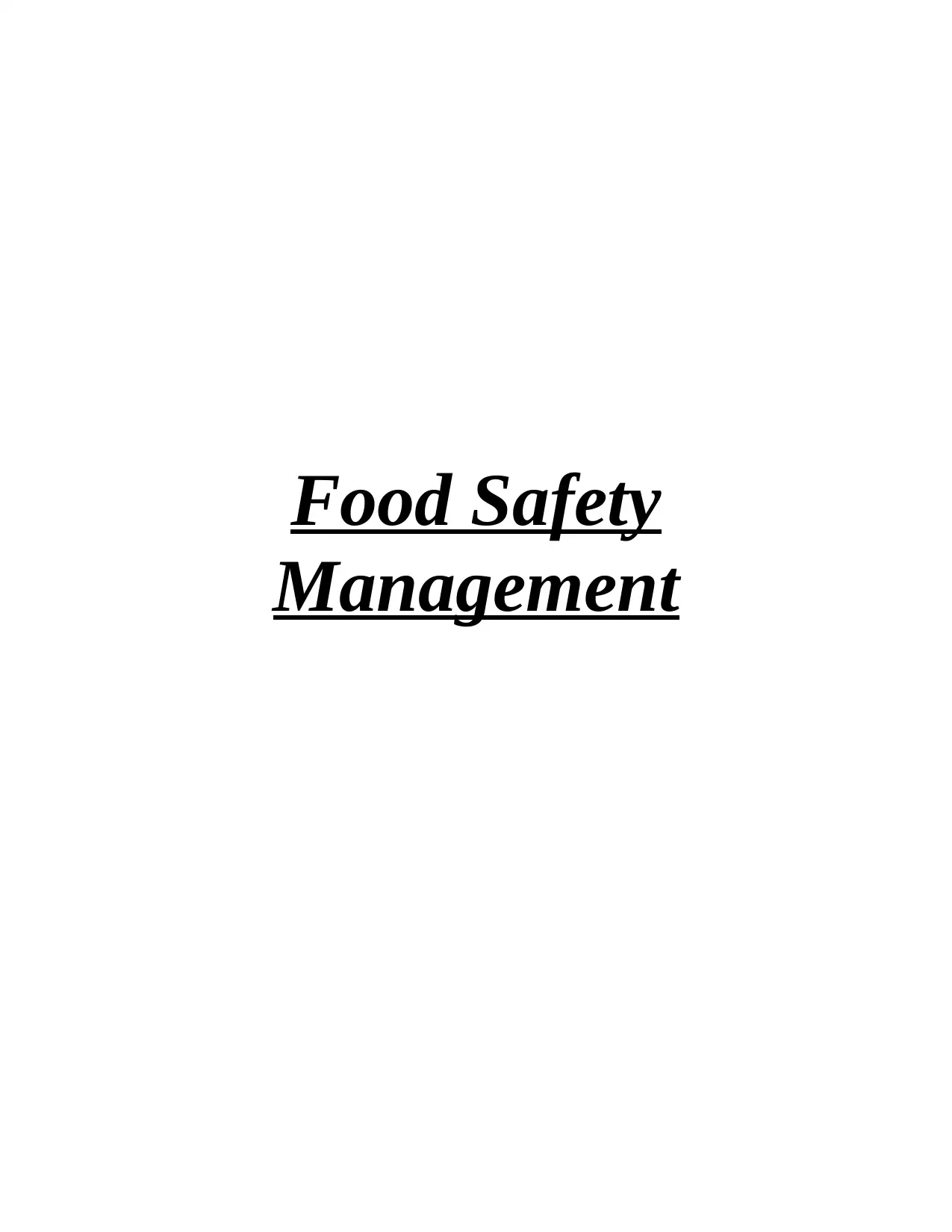
Food Safety
Management
Management
Paraphrase This Document
Need a fresh take? Get an instant paraphrase of this document with our AI Paraphraser
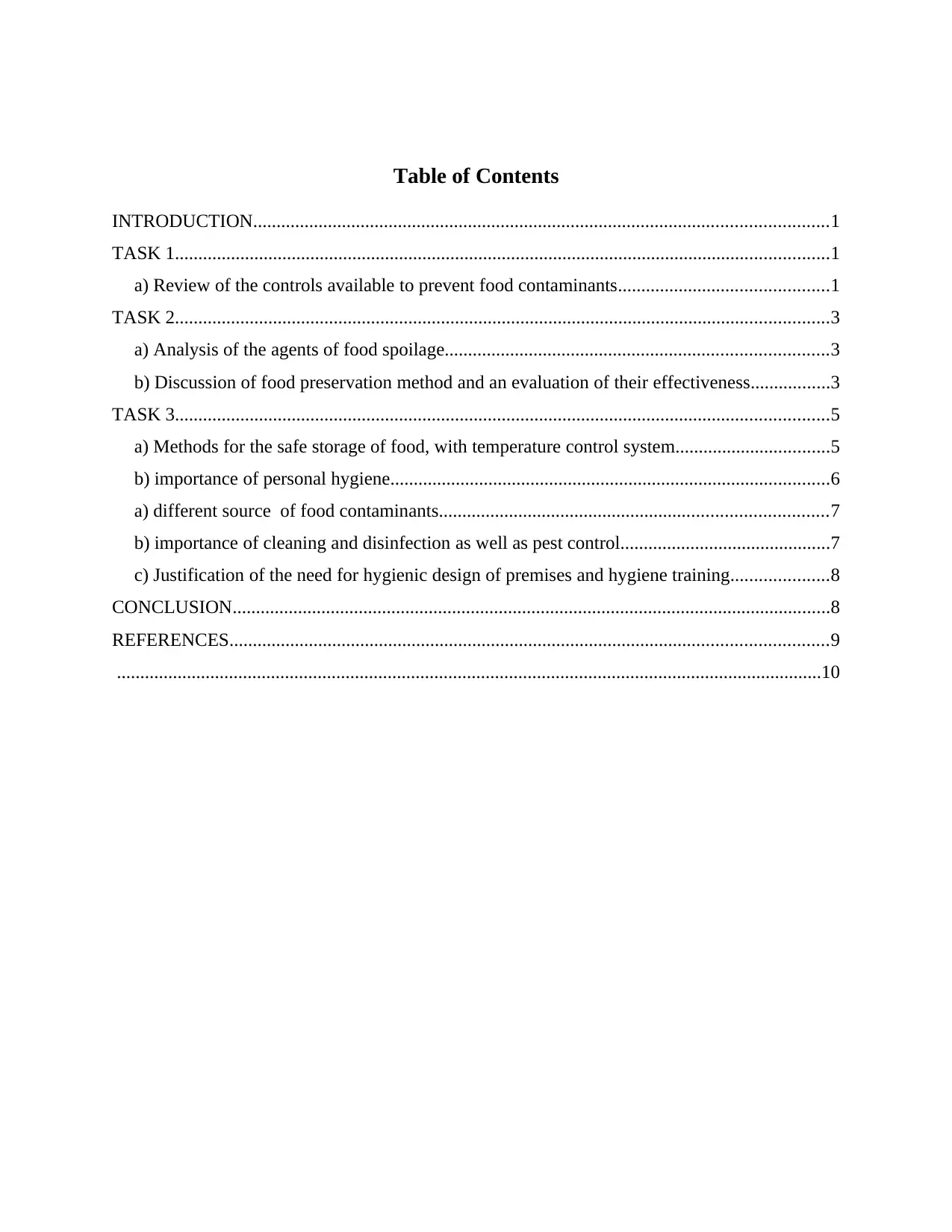
Table of Contents
INTRODUCTION...........................................................................................................................1
TASK 1............................................................................................................................................1
a) Review of the controls available to prevent food contaminants.............................................1
TASK 2............................................................................................................................................3
a) Analysis of the agents of food spoilage..................................................................................3
b) Discussion of food preservation method and an evaluation of their effectiveness.................3
TASK 3............................................................................................................................................5
a) Methods for the safe storage of food, with temperature control system.................................5
b) importance of personal hygiene..............................................................................................6
a) different source of food contaminants...................................................................................7
b) importance of cleaning and disinfection as well as pest control.............................................7
c) Justification of the need for hygienic design of premises and hygiene training.....................8
CONCLUSION................................................................................................................................8
REFERENCES................................................................................................................................9
.......................................................................................................................................................10
INTRODUCTION...........................................................................................................................1
TASK 1............................................................................................................................................1
a) Review of the controls available to prevent food contaminants.............................................1
TASK 2............................................................................................................................................3
a) Analysis of the agents of food spoilage..................................................................................3
b) Discussion of food preservation method and an evaluation of their effectiveness.................3
TASK 3............................................................................................................................................5
a) Methods for the safe storage of food, with temperature control system.................................5
b) importance of personal hygiene..............................................................................................6
a) different source of food contaminants...................................................................................7
b) importance of cleaning and disinfection as well as pest control.............................................7
c) Justification of the need for hygienic design of premises and hygiene training.....................8
CONCLUSION................................................................................................................................8
REFERENCES................................................................................................................................9
.......................................................................................................................................................10
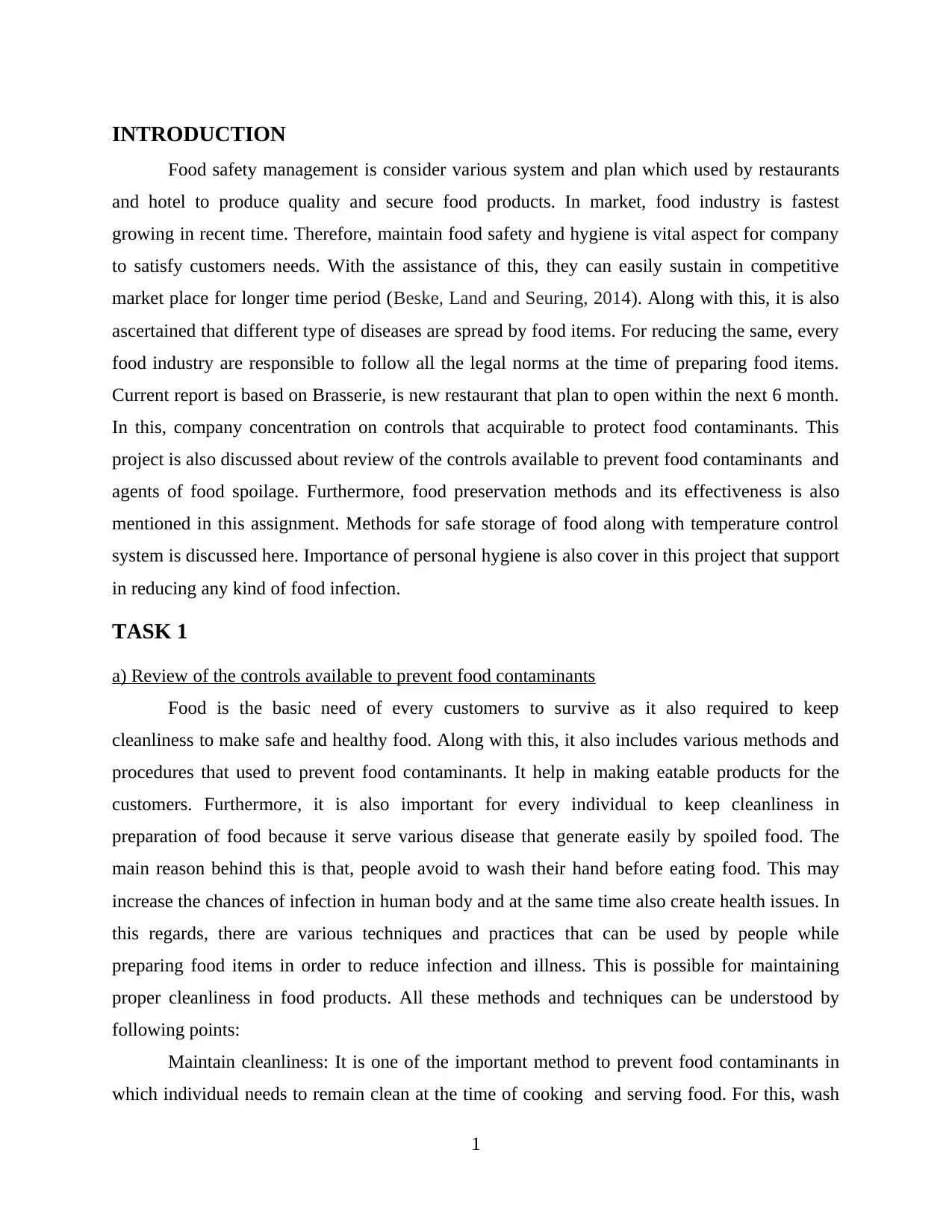
INTRODUCTION
Food safety management is consider various system and plan which used by restaurants
and hotel to produce quality and secure food products. In market, food industry is fastest
growing in recent time. Therefore, maintain food safety and hygiene is vital aspect for company
to satisfy customers needs. With the assistance of this, they can easily sustain in competitive
market place for longer time period (Beske, Land and Seuring, 2014). Along with this, it is also
ascertained that different type of diseases are spread by food items. For reducing the same, every
food industry are responsible to follow all the legal norms at the time of preparing food items.
Current report is based on Brasserie, is new restaurant that plan to open within the next 6 month.
In this, company concentration on controls that acquirable to protect food contaminants. This
project is also discussed about review of the controls available to prevent food contaminants and
agents of food spoilage. Furthermore, food preservation methods and its effectiveness is also
mentioned in this assignment. Methods for safe storage of food along with temperature control
system is discussed here. Importance of personal hygiene is also cover in this project that support
in reducing any kind of food infection.
TASK 1
a) Review of the controls available to prevent food contaminants
Food is the basic need of every customers to survive as it also required to keep
cleanliness to make safe and healthy food. Along with this, it also includes various methods and
procedures that used to prevent food contaminants. It help in making eatable products for the
customers. Furthermore, it is also important for every individual to keep cleanliness in
preparation of food because it serve various disease that generate easily by spoiled food. The
main reason behind this is that, people avoid to wash their hand before eating food. This may
increase the chances of infection in human body and at the same time also create health issues. In
this regards, there are various techniques and practices that can be used by people while
preparing food items in order to reduce infection and illness. This is possible for maintaining
proper cleanliness in food products. All these methods and techniques can be understood by
following points:
Maintain cleanliness: It is one of the important method to prevent food contaminants in
which individual needs to remain clean at the time of cooking and serving food. For this, wash
1
Food safety management is consider various system and plan which used by restaurants
and hotel to produce quality and secure food products. In market, food industry is fastest
growing in recent time. Therefore, maintain food safety and hygiene is vital aspect for company
to satisfy customers needs. With the assistance of this, they can easily sustain in competitive
market place for longer time period (Beske, Land and Seuring, 2014). Along with this, it is also
ascertained that different type of diseases are spread by food items. For reducing the same, every
food industry are responsible to follow all the legal norms at the time of preparing food items.
Current report is based on Brasserie, is new restaurant that plan to open within the next 6 month.
In this, company concentration on controls that acquirable to protect food contaminants. This
project is also discussed about review of the controls available to prevent food contaminants and
agents of food spoilage. Furthermore, food preservation methods and its effectiveness is also
mentioned in this assignment. Methods for safe storage of food along with temperature control
system is discussed here. Importance of personal hygiene is also cover in this project that support
in reducing any kind of food infection.
TASK 1
a) Review of the controls available to prevent food contaminants
Food is the basic need of every customers to survive as it also required to keep
cleanliness to make safe and healthy food. Along with this, it also includes various methods and
procedures that used to prevent food contaminants. It help in making eatable products for the
customers. Furthermore, it is also important for every individual to keep cleanliness in
preparation of food because it serve various disease that generate easily by spoiled food. The
main reason behind this is that, people avoid to wash their hand before eating food. This may
increase the chances of infection in human body and at the same time also create health issues. In
this regards, there are various techniques and practices that can be used by people while
preparing food items in order to reduce infection and illness. This is possible for maintaining
proper cleanliness in food products. All these methods and techniques can be understood by
following points:
Maintain cleanliness: It is one of the important method to prevent food contaminants in
which individual needs to remain clean at the time of cooking and serving food. For this, wash
1
⊘ This is a preview!⊘
Do you want full access?
Subscribe today to unlock all pages.

Trusted by 1+ million students worldwide
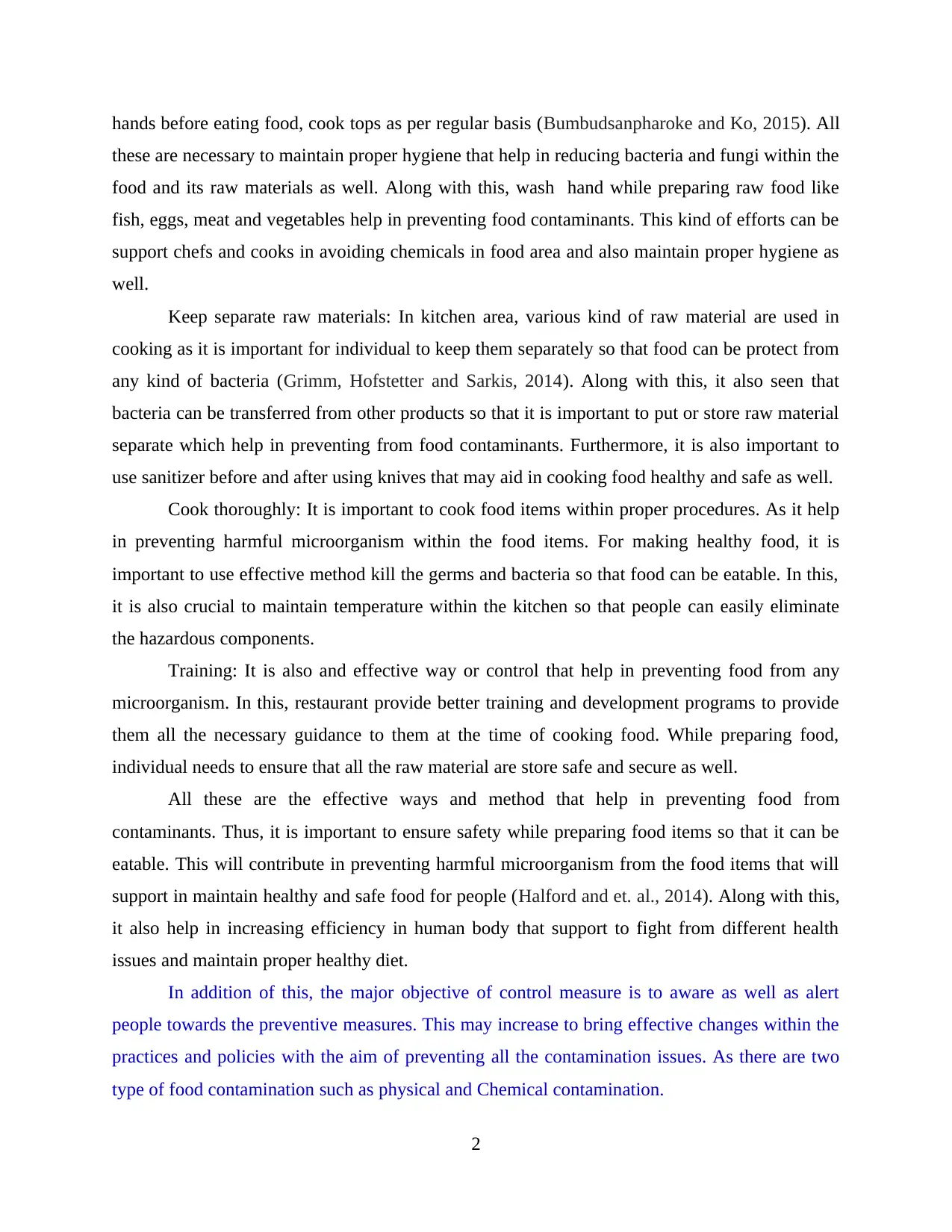
hands before eating food, cook tops as per regular basis (Bumbudsanpharoke and Ko, 2015). All
these are necessary to maintain proper hygiene that help in reducing bacteria and fungi within the
food and its raw materials as well. Along with this, wash hand while preparing raw food like
fish, eggs, meat and vegetables help in preventing food contaminants. This kind of efforts can be
support chefs and cooks in avoiding chemicals in food area and also maintain proper hygiene as
well.
Keep separate raw materials: In kitchen area, various kind of raw material are used in
cooking as it is important for individual to keep them separately so that food can be protect from
any kind of bacteria (Grimm, Hofstetter and Sarkis, 2014). Along with this, it also seen that
bacteria can be transferred from other products so that it is important to put or store raw material
separate which help in preventing from food contaminants. Furthermore, it is also important to
use sanitizer before and after using knives that may aid in cooking food healthy and safe as well.
Cook thoroughly: It is important to cook food items within proper procedures. As it help
in preventing harmful microorganism within the food items. For making healthy food, it is
important to use effective method kill the germs and bacteria so that food can be eatable. In this,
it is also crucial to maintain temperature within the kitchen so that people can easily eliminate
the hazardous components.
Training: It is also and effective way or control that help in preventing food from any
microorganism. In this, restaurant provide better training and development programs to provide
them all the necessary guidance to them at the time of cooking food. While preparing food,
individual needs to ensure that all the raw material are store safe and secure as well.
All these are the effective ways and method that help in preventing food from
contaminants. Thus, it is important to ensure safety while preparing food items so that it can be
eatable. This will contribute in preventing harmful microorganism from the food items that will
support in maintain healthy and safe food for people (Halford and et. al., 2014). Along with this,
it also help in increasing efficiency in human body that support to fight from different health
issues and maintain proper healthy diet.
In addition of this, the major objective of control measure is to aware as well as alert
people towards the preventive measures. This may increase to bring effective changes within the
practices and policies with the aim of preventing all the contamination issues. As there are two
type of food contamination such as physical and Chemical contamination.
2
these are necessary to maintain proper hygiene that help in reducing bacteria and fungi within the
food and its raw materials as well. Along with this, wash hand while preparing raw food like
fish, eggs, meat and vegetables help in preventing food contaminants. This kind of efforts can be
support chefs and cooks in avoiding chemicals in food area and also maintain proper hygiene as
well.
Keep separate raw materials: In kitchen area, various kind of raw material are used in
cooking as it is important for individual to keep them separately so that food can be protect from
any kind of bacteria (Grimm, Hofstetter and Sarkis, 2014). Along with this, it also seen that
bacteria can be transferred from other products so that it is important to put or store raw material
separate which help in preventing from food contaminants. Furthermore, it is also important to
use sanitizer before and after using knives that may aid in cooking food healthy and safe as well.
Cook thoroughly: It is important to cook food items within proper procedures. As it help
in preventing harmful microorganism within the food items. For making healthy food, it is
important to use effective method kill the germs and bacteria so that food can be eatable. In this,
it is also crucial to maintain temperature within the kitchen so that people can easily eliminate
the hazardous components.
Training: It is also and effective way or control that help in preventing food from any
microorganism. In this, restaurant provide better training and development programs to provide
them all the necessary guidance to them at the time of cooking food. While preparing food,
individual needs to ensure that all the raw material are store safe and secure as well.
All these are the effective ways and method that help in preventing food from
contaminants. Thus, it is important to ensure safety while preparing food items so that it can be
eatable. This will contribute in preventing harmful microorganism from the food items that will
support in maintain healthy and safe food for people (Halford and et. al., 2014). Along with this,
it also help in increasing efficiency in human body that support to fight from different health
issues and maintain proper healthy diet.
In addition of this, the major objective of control measure is to aware as well as alert
people towards the preventive measures. This may increase to bring effective changes within the
practices and policies with the aim of preventing all the contamination issues. As there are two
type of food contamination such as physical and Chemical contamination.
2
Paraphrase This Document
Need a fresh take? Get an instant paraphrase of this document with our AI Paraphraser
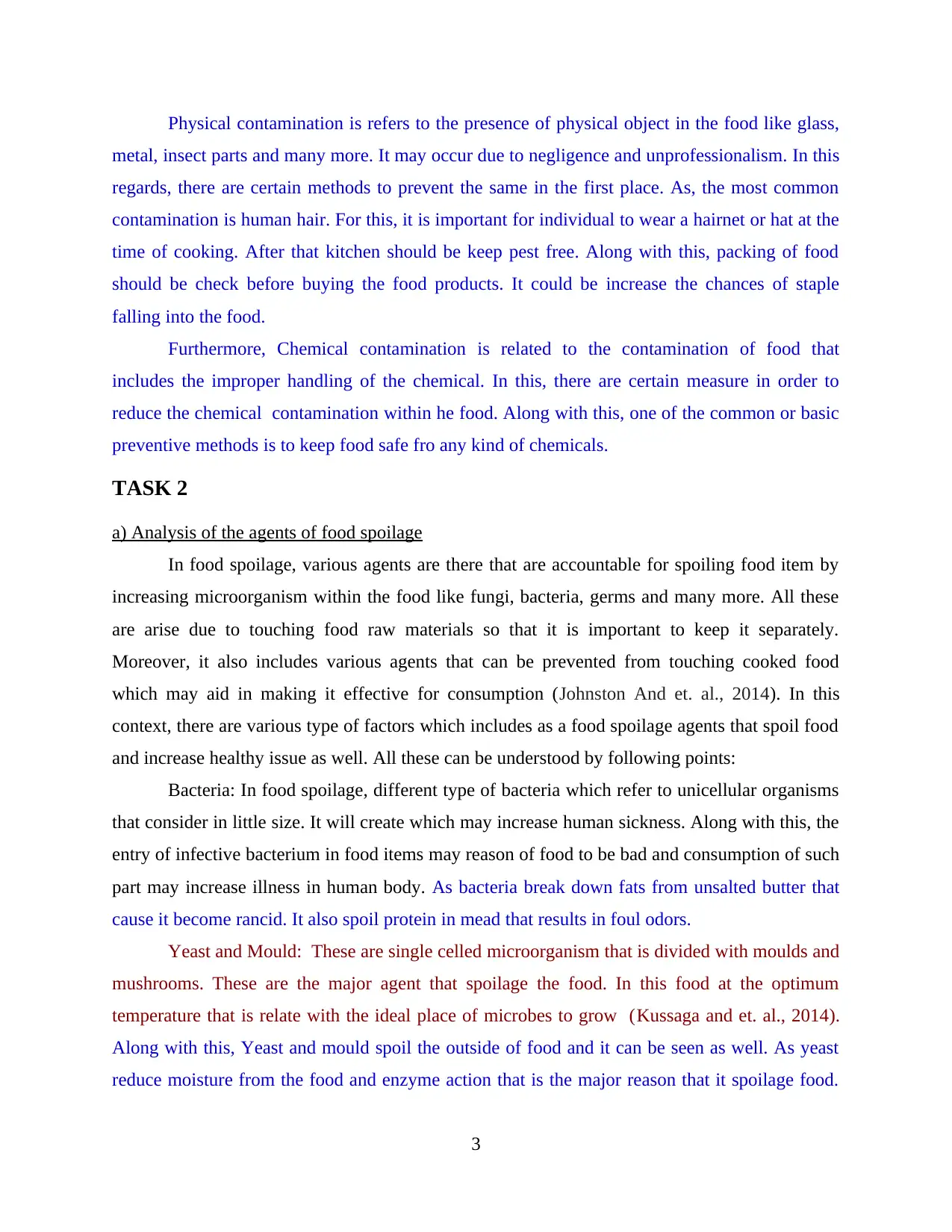
Physical contamination is refers to the presence of physical object in the food like glass,
metal, insect parts and many more. It may occur due to negligence and unprofessionalism. In this
regards, there are certain methods to prevent the same in the first place. As, the most common
contamination is human hair. For this, it is important for individual to wear a hairnet or hat at the
time of cooking. After that kitchen should be keep pest free. Along with this, packing of food
should be check before buying the food products. It could be increase the chances of staple
falling into the food.
Furthermore, Chemical contamination is related to the contamination of food that
includes the improper handling of the chemical. In this, there are certain measure in order to
reduce the chemical contamination within he food. Along with this, one of the common or basic
preventive methods is to keep food safe fro any kind of chemicals.
TASK 2
a) Analysis of the agents of food spoilage
In food spoilage, various agents are there that are accountable for spoiling food item by
increasing microorganism within the food like fungi, bacteria, germs and many more. All these
are arise due to touching food raw materials so that it is important to keep it separately.
Moreover, it also includes various agents that can be prevented from touching cooked food
which may aid in making it effective for consumption (Johnston And et. al., 2014). In this
context, there are various type of factors which includes as a food spoilage agents that spoil food
and increase healthy issue as well. All these can be understood by following points:
Bacteria: In food spoilage, different type of bacteria which refer to unicellular organisms
that consider in little size. It will create which may increase human sickness. Along with this, the
entry of infective bacterium in food items may reason of food to be bad and consumption of such
part may increase illness in human body. As bacteria break down fats from unsalted butter that
cause it become rancid. It also spoil protein in mead that results in foul odors.
Yeast and Mould: These are single celled microorganism that is divided with moulds and
mushrooms. These are the major agent that spoilage the food. In this food at the optimum
temperature that is relate with the ideal place of microbes to grow (Kussaga and et. al., 2014).
Along with this, Yeast and mould spoil the outside of food and it can be seen as well. As yeast
reduce moisture from the food and enzyme action that is the major reason that it spoilage food.
3
metal, insect parts and many more. It may occur due to negligence and unprofessionalism. In this
regards, there are certain methods to prevent the same in the first place. As, the most common
contamination is human hair. For this, it is important for individual to wear a hairnet or hat at the
time of cooking. After that kitchen should be keep pest free. Along with this, packing of food
should be check before buying the food products. It could be increase the chances of staple
falling into the food.
Furthermore, Chemical contamination is related to the contamination of food that
includes the improper handling of the chemical. In this, there are certain measure in order to
reduce the chemical contamination within he food. Along with this, one of the common or basic
preventive methods is to keep food safe fro any kind of chemicals.
TASK 2
a) Analysis of the agents of food spoilage
In food spoilage, various agents are there that are accountable for spoiling food item by
increasing microorganism within the food like fungi, bacteria, germs and many more. All these
are arise due to touching food raw materials so that it is important to keep it separately.
Moreover, it also includes various agents that can be prevented from touching cooked food
which may aid in making it effective for consumption (Johnston And et. al., 2014). In this
context, there are various type of factors which includes as a food spoilage agents that spoil food
and increase healthy issue as well. All these can be understood by following points:
Bacteria: In food spoilage, different type of bacteria which refer to unicellular organisms
that consider in little size. It will create which may increase human sickness. Along with this, the
entry of infective bacterium in food items may reason of food to be bad and consumption of such
part may increase illness in human body. As bacteria break down fats from unsalted butter that
cause it become rancid. It also spoil protein in mead that results in foul odors.
Yeast and Mould: These are single celled microorganism that is divided with moulds and
mushrooms. These are the major agent that spoilage the food. In this food at the optimum
temperature that is relate with the ideal place of microbes to grow (Kussaga and et. al., 2014).
Along with this, Yeast and mould spoil the outside of food and it can be seen as well. As yeast
reduce moisture from the food and enzyme action that is the major reason that it spoilage food.
3
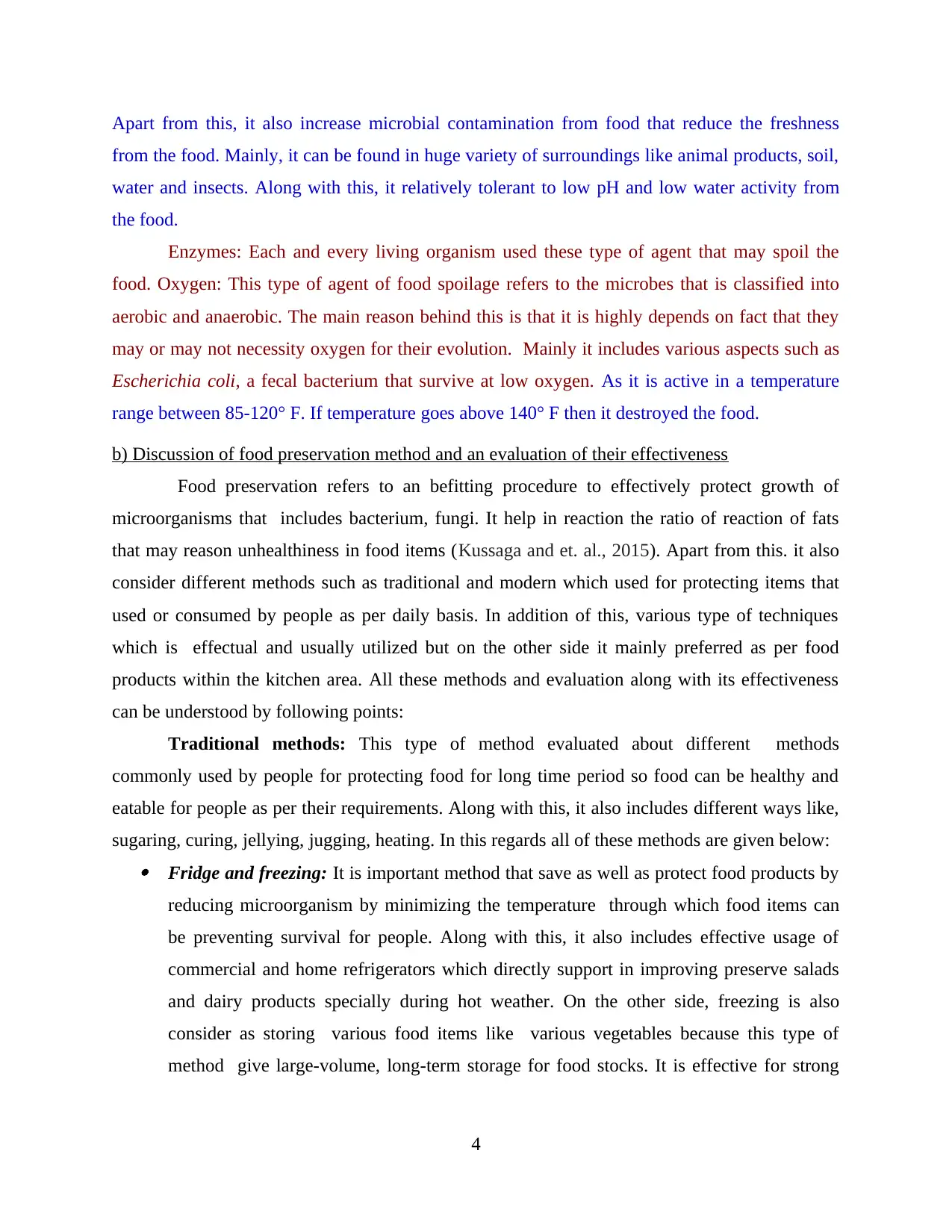
Apart from this, it also increase microbial contamination from food that reduce the freshness
from the food. Mainly, it can be found in huge variety of surroundings like animal products, soil,
water and insects. Along with this, it relatively tolerant to low pH and low water activity from
the food.
Enzymes: Each and every living organism used these type of agent that may spoil the
food. Oxygen: This type of agent of food spoilage refers to the microbes that is classified into
aerobic and anaerobic. The main reason behind this is that it is highly depends on fact that they
may or may not necessity oxygen for their evolution. Mainly it includes various aspects such as
Escherichia coli, a fecal bacterium that survive at low oxygen. As it is active in a temperature
range between 85-120° F. If temperature goes above 140° F then it destroyed the food.
b) Discussion of food preservation method and an evaluation of their effectiveness
Food preservation refers to an befitting procedure to effectively protect growth of
microorganisms that includes bacterium, fungi. It help in reaction the ratio of reaction of fats
that may reason unhealthiness in food items (Kussaga and et. al., 2015). Apart from this. it also
consider different methods such as traditional and modern which used for protecting items that
used or consumed by people as per daily basis. In addition of this, various type of techniques
which is effectual and usually utilized but on the other side it mainly preferred as per food
products within the kitchen area. All these methods and evaluation along with its effectiveness
can be understood by following points:
Traditional methods: This type of method evaluated about different methods
commonly used by people for protecting food for long time period so food can be healthy and
eatable for people as per their requirements. Along with this, it also includes different ways like,
sugaring, curing, jellying, jugging, heating. In this regards all of these methods are given below: Fridge and freezing: It is important method that save as well as protect food products by
reducing microorganism by minimizing the temperature through which food items can
be preventing survival for people. Along with this, it also includes effective usage of
commercial and home refrigerators which directly support in improving preserve salads
and dairy products specially during hot weather. On the other side, freezing is also
consider as storing various food items like various vegetables because this type of
method give large-volume, long-term storage for food stocks. It is effective for strong
4
from the food. Mainly, it can be found in huge variety of surroundings like animal products, soil,
water and insects. Along with this, it relatively tolerant to low pH and low water activity from
the food.
Enzymes: Each and every living organism used these type of agent that may spoil the
food. Oxygen: This type of agent of food spoilage refers to the microbes that is classified into
aerobic and anaerobic. The main reason behind this is that it is highly depends on fact that they
may or may not necessity oxygen for their evolution. Mainly it includes various aspects such as
Escherichia coli, a fecal bacterium that survive at low oxygen. As it is active in a temperature
range between 85-120° F. If temperature goes above 140° F then it destroyed the food.
b) Discussion of food preservation method and an evaluation of their effectiveness
Food preservation refers to an befitting procedure to effectively protect growth of
microorganisms that includes bacterium, fungi. It help in reaction the ratio of reaction of fats
that may reason unhealthiness in food items (Kussaga and et. al., 2015). Apart from this. it also
consider different methods such as traditional and modern which used for protecting items that
used or consumed by people as per daily basis. In addition of this, various type of techniques
which is effectual and usually utilized but on the other side it mainly preferred as per food
products within the kitchen area. All these methods and evaluation along with its effectiveness
can be understood by following points:
Traditional methods: This type of method evaluated about different methods
commonly used by people for protecting food for long time period so food can be healthy and
eatable for people as per their requirements. Along with this, it also includes different ways like,
sugaring, curing, jellying, jugging, heating. In this regards all of these methods are given below: Fridge and freezing: It is important method that save as well as protect food products by
reducing microorganism by minimizing the temperature through which food items can
be preventing survival for people. Along with this, it also includes effective usage of
commercial and home refrigerators which directly support in improving preserve salads
and dairy products specially during hot weather. On the other side, freezing is also
consider as storing various food items like various vegetables because this type of
method give large-volume, long-term storage for food stocks. It is effective for strong
4
⊘ This is a preview!⊘
Do you want full access?
Subscribe today to unlock all pages.

Trusted by 1+ million students worldwide
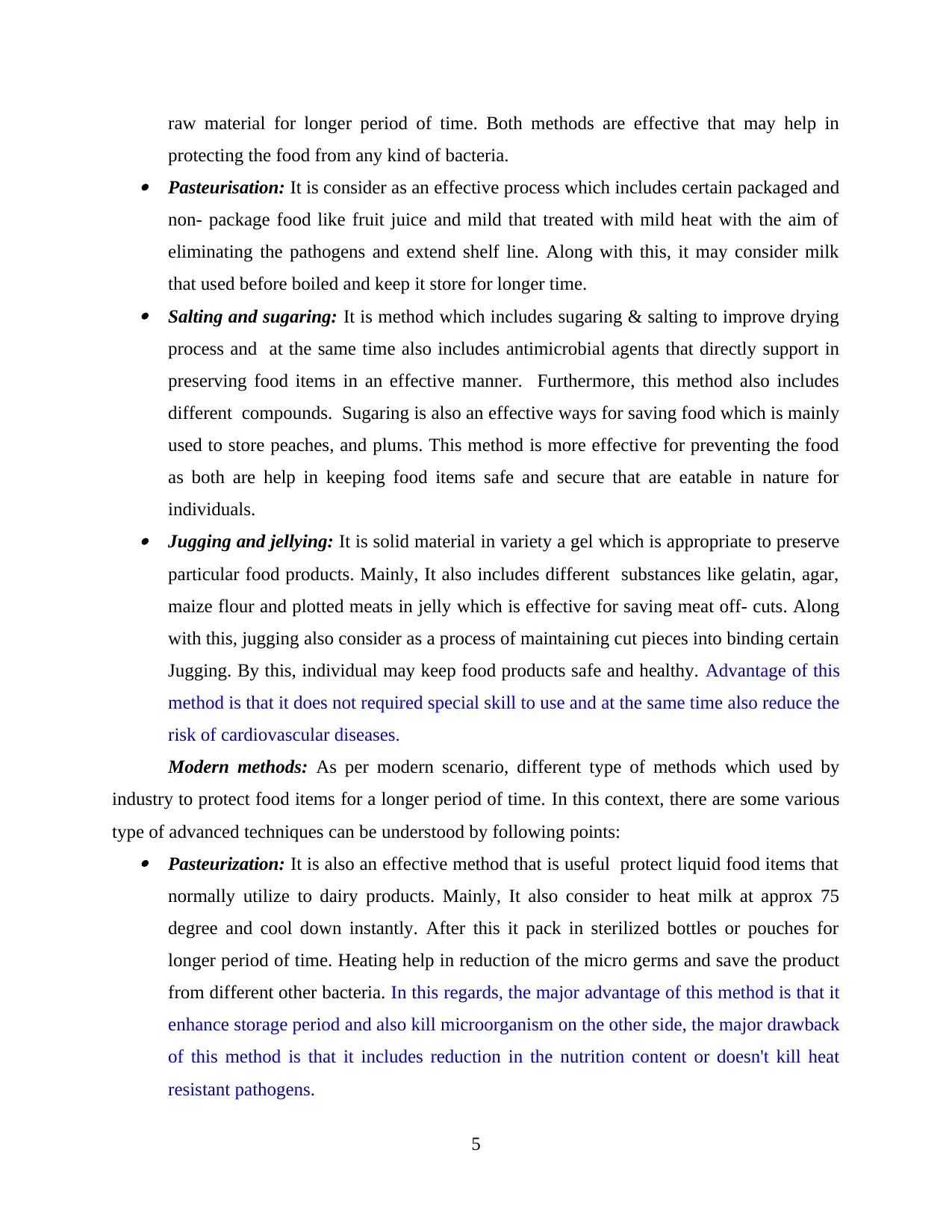
raw material for longer period of time. Both methods are effective that may help in
protecting the food from any kind of bacteria. Pasteurisation: It is consider as an effective process which includes certain packaged and
non- package food like fruit juice and mild that treated with mild heat with the aim of
eliminating the pathogens and extend shelf line. Along with this, it may consider milk
that used before boiled and keep it store for longer time. Salting and sugaring: It is method which includes sugaring & salting to improve drying
process and at the same time also includes antimicrobial agents that directly support in
preserving food items in an effective manner. Furthermore, this method also includes
different compounds. Sugaring is also an effective ways for saving food which is mainly
used to store peaches, and plums. This method is more effective for preventing the food
as both are help in keeping food items safe and secure that are eatable in nature for
individuals. Jugging and jellying: It is solid material in variety a gel which is appropriate to preserve
particular food products. Mainly, It also includes different substances like gelatin, agar,
maize flour and plotted meats in jelly which is effective for saving meat off- cuts. Along
with this, jugging also consider as a process of maintaining cut pieces into binding certain
Jugging. By this, individual may keep food products safe and healthy. Advantage of this
method is that it does not required special skill to use and at the same time also reduce the
risk of cardiovascular diseases.
Modern methods: As per modern scenario, different type of methods which used by
industry to protect food items for a longer period of time. In this context, there are some various
type of advanced techniques can be understood by following points: Pasteurization: It is also an effective method that is useful protect liquid food items that
normally utilize to dairy products. Mainly, It also consider to heat milk at approx 75
degree and cool down instantly. After this it pack in sterilized bottles or pouches for
longer period of time. Heating help in reduction of the micro germs and save the product
from different other bacteria. In this regards, the major advantage of this method is that it
enhance storage period and also kill microorganism on the other side, the major drawback
of this method is that it includes reduction in the nutrition content or doesn't kill heat
resistant pathogens.
5
protecting the food from any kind of bacteria. Pasteurisation: It is consider as an effective process which includes certain packaged and
non- package food like fruit juice and mild that treated with mild heat with the aim of
eliminating the pathogens and extend shelf line. Along with this, it may consider milk
that used before boiled and keep it store for longer time. Salting and sugaring: It is method which includes sugaring & salting to improve drying
process and at the same time also includes antimicrobial agents that directly support in
preserving food items in an effective manner. Furthermore, this method also includes
different compounds. Sugaring is also an effective ways for saving food which is mainly
used to store peaches, and plums. This method is more effective for preventing the food
as both are help in keeping food items safe and secure that are eatable in nature for
individuals. Jugging and jellying: It is solid material in variety a gel which is appropriate to preserve
particular food products. Mainly, It also includes different substances like gelatin, agar,
maize flour and plotted meats in jelly which is effective for saving meat off- cuts. Along
with this, jugging also consider as a process of maintaining cut pieces into binding certain
Jugging. By this, individual may keep food products safe and healthy. Advantage of this
method is that it does not required special skill to use and at the same time also reduce the
risk of cardiovascular diseases.
Modern methods: As per modern scenario, different type of methods which used by
industry to protect food items for a longer period of time. In this context, there are some various
type of advanced techniques can be understood by following points: Pasteurization: It is also an effective method that is useful protect liquid food items that
normally utilize to dairy products. Mainly, It also consider to heat milk at approx 75
degree and cool down instantly. After this it pack in sterilized bottles or pouches for
longer period of time. Heating help in reduction of the micro germs and save the product
from different other bacteria. In this regards, the major advantage of this method is that it
enhance storage period and also kill microorganism on the other side, the major drawback
of this method is that it includes reduction in the nutrition content or doesn't kill heat
resistant pathogens.
5
Paraphrase This Document
Need a fresh take? Get an instant paraphrase of this document with our AI Paraphraser
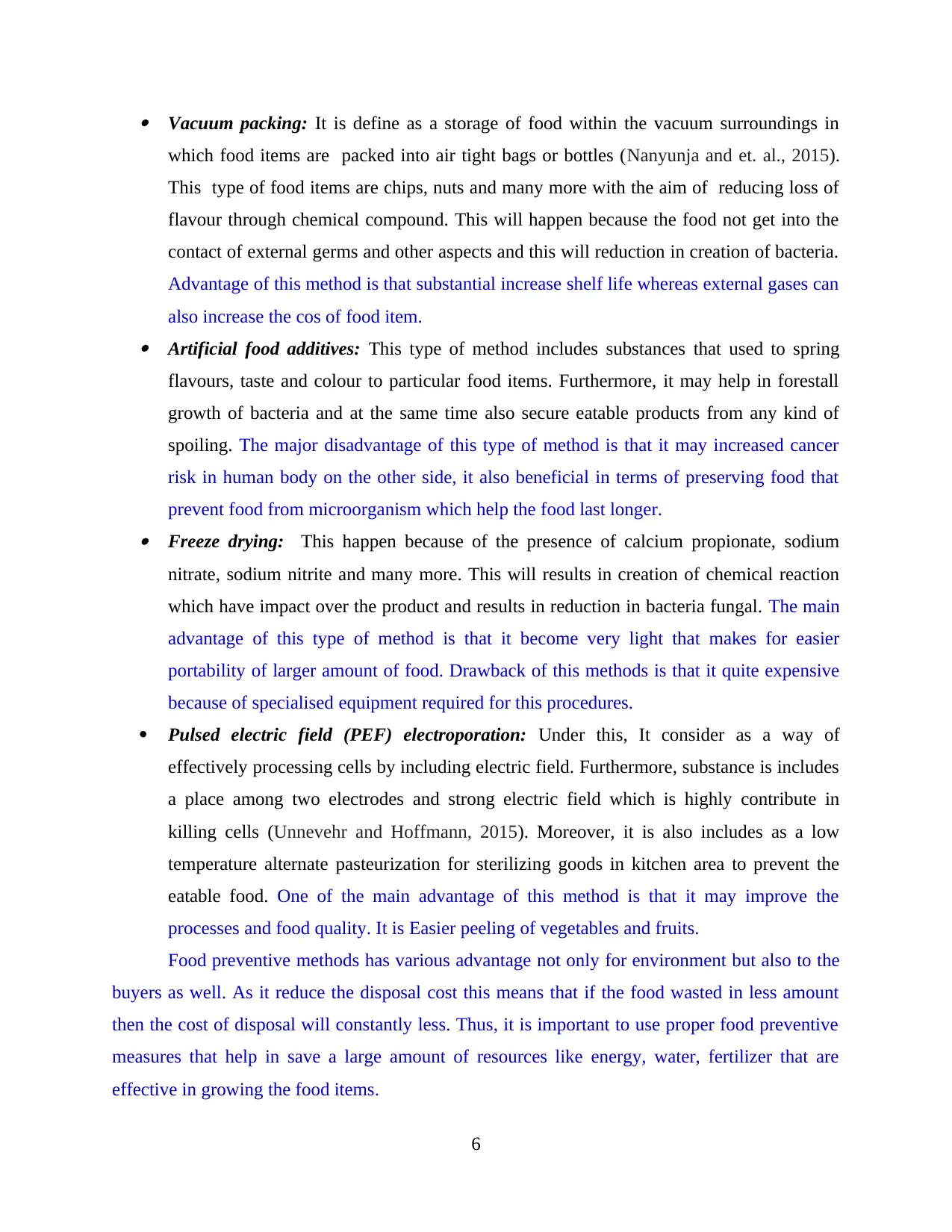
Vacuum packing: It is define as a storage of food within the vacuum surroundings in
which food items are packed into air tight bags or bottles (Nanyunja and et. al., 2015).
This type of food items are chips, nuts and many more with the aim of reducing loss of
flavour through chemical compound. This will happen because the food not get into the
contact of external germs and other aspects and this will reduction in creation of bacteria.
Advantage of this method is that substantial increase shelf life whereas external gases can
also increase the cos of food item. Artificial food additives: This type of method includes substances that used to spring
flavours, taste and colour to particular food items. Furthermore, it may help in forestall
growth of bacteria and at the same time also secure eatable products from any kind of
spoiling. The major disadvantage of this type of method is that it may increased cancer
risk in human body on the other side, it also beneficial in terms of preserving food that
prevent food from microorganism which help the food last longer. Freeze drying: This happen because of the presence of calcium propionate, sodium
nitrate, sodium nitrite and many more. This will results in creation of chemical reaction
which have impact over the product and results in reduction in bacteria fungal. The main
advantage of this type of method is that it become very light that makes for easier
portability of larger amount of food. Drawback of this methods is that it quite expensive
because of specialised equipment required for this procedures.
Pulsed electric field (PEF) electroporation: Under this, It consider as a way of
effectively processing cells by including electric field. Furthermore, substance is includes
a place among two electrodes and strong electric field which is highly contribute in
killing cells (Unnevehr and Hoffmann, 2015). Moreover, it is also includes as a low
temperature alternate pasteurization for sterilizing goods in kitchen area to prevent the
eatable food. One of the main advantage of this method is that it may improve the
processes and food quality. It is Easier peeling of vegetables and fruits.
Food preventive methods has various advantage not only for environment but also to the
buyers as well. As it reduce the disposal cost this means that if the food wasted in less amount
then the cost of disposal will constantly less. Thus, it is important to use proper food preventive
measures that help in save a large amount of resources like energy, water, fertilizer that are
effective in growing the food items.
6
which food items are packed into air tight bags or bottles (Nanyunja and et. al., 2015).
This type of food items are chips, nuts and many more with the aim of reducing loss of
flavour through chemical compound. This will happen because the food not get into the
contact of external germs and other aspects and this will reduction in creation of bacteria.
Advantage of this method is that substantial increase shelf life whereas external gases can
also increase the cos of food item. Artificial food additives: This type of method includes substances that used to spring
flavours, taste and colour to particular food items. Furthermore, it may help in forestall
growth of bacteria and at the same time also secure eatable products from any kind of
spoiling. The major disadvantage of this type of method is that it may increased cancer
risk in human body on the other side, it also beneficial in terms of preserving food that
prevent food from microorganism which help the food last longer. Freeze drying: This happen because of the presence of calcium propionate, sodium
nitrate, sodium nitrite and many more. This will results in creation of chemical reaction
which have impact over the product and results in reduction in bacteria fungal. The main
advantage of this type of method is that it become very light that makes for easier
portability of larger amount of food. Drawback of this methods is that it quite expensive
because of specialised equipment required for this procedures.
Pulsed electric field (PEF) electroporation: Under this, It consider as a way of
effectively processing cells by including electric field. Furthermore, substance is includes
a place among two electrodes and strong electric field which is highly contribute in
killing cells (Unnevehr and Hoffmann, 2015). Moreover, it is also includes as a low
temperature alternate pasteurization for sterilizing goods in kitchen area to prevent the
eatable food. One of the main advantage of this method is that it may improve the
processes and food quality. It is Easier peeling of vegetables and fruits.
Food preventive methods has various advantage not only for environment but also to the
buyers as well. As it reduce the disposal cost this means that if the food wasted in less amount
then the cost of disposal will constantly less. Thus, it is important to use proper food preventive
measures that help in save a large amount of resources like energy, water, fertilizer that are
effective in growing the food items.
6
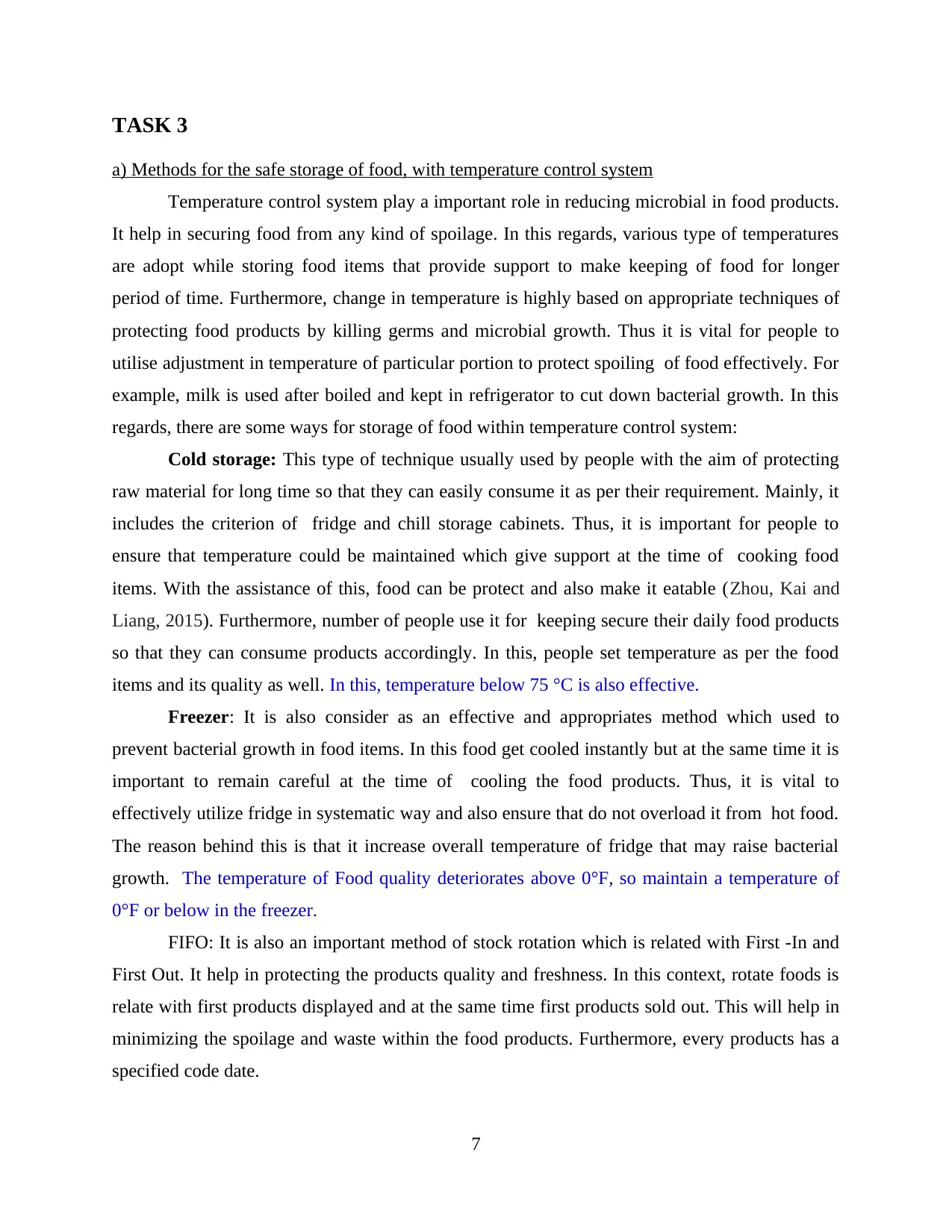
TASK 3
a) Methods for the safe storage of food, with temperature control system
Temperature control system play a important role in reducing microbial in food products.
It help in securing food from any kind of spoilage. In this regards, various type of temperatures
are adopt while storing food items that provide support to make keeping of food for longer
period of time. Furthermore, change in temperature is highly based on appropriate techniques of
protecting food products by killing germs and microbial growth. Thus it is vital for people to
utilise adjustment in temperature of particular portion to protect spoiling of food effectively. For
example, milk is used after boiled and kept in refrigerator to cut down bacterial growth. In this
regards, there are some ways for storage of food within temperature control system:
Cold storage: This type of technique usually used by people with the aim of protecting
raw material for long time so that they can easily consume it as per their requirement. Mainly, it
includes the criterion of fridge and chill storage cabinets. Thus, it is important for people to
ensure that temperature could be maintained which give support at the time of cooking food
items. With the assistance of this, food can be protect and also make it eatable (Zhou, Kai and
Liang, 2015). Furthermore, number of people use it for keeping secure their daily food products
so that they can consume products accordingly. In this, people set temperature as per the food
items and its quality as well. In this, temperature below 75 °C is also effective.
Freezer: It is also consider as an effective and appropriates method which used to
prevent bacterial growth in food items. In this food get cooled instantly but at the same time it is
important to remain careful at the time of cooling the food products. Thus, it is vital to
effectively utilize fridge in systematic way and also ensure that do not overload it from hot food.
The reason behind this is that it increase overall temperature of fridge that may raise bacterial
growth. The temperature of Food quality deteriorates above 0°F, so maintain a temperature of
0°F or below in the freezer.
FIFO: It is also an important method of stock rotation which is related with First -In and
First Out. It help in protecting the products quality and freshness. In this context, rotate foods is
relate with first products displayed and at the same time first products sold out. This will help in
minimizing the spoilage and waste within the food products. Furthermore, every products has a
specified code date.
7
a) Methods for the safe storage of food, with temperature control system
Temperature control system play a important role in reducing microbial in food products.
It help in securing food from any kind of spoilage. In this regards, various type of temperatures
are adopt while storing food items that provide support to make keeping of food for longer
period of time. Furthermore, change in temperature is highly based on appropriate techniques of
protecting food products by killing germs and microbial growth. Thus it is vital for people to
utilise adjustment in temperature of particular portion to protect spoiling of food effectively. For
example, milk is used after boiled and kept in refrigerator to cut down bacterial growth. In this
regards, there are some ways for storage of food within temperature control system:
Cold storage: This type of technique usually used by people with the aim of protecting
raw material for long time so that they can easily consume it as per their requirement. Mainly, it
includes the criterion of fridge and chill storage cabinets. Thus, it is important for people to
ensure that temperature could be maintained which give support at the time of cooking food
items. With the assistance of this, food can be protect and also make it eatable (Zhou, Kai and
Liang, 2015). Furthermore, number of people use it for keeping secure their daily food products
so that they can consume products accordingly. In this, people set temperature as per the food
items and its quality as well. In this, temperature below 75 °C is also effective.
Freezer: It is also consider as an effective and appropriates method which used to
prevent bacterial growth in food items. In this food get cooled instantly but at the same time it is
important to remain careful at the time of cooling the food products. Thus, it is vital to
effectively utilize fridge in systematic way and also ensure that do not overload it from hot food.
The reason behind this is that it increase overall temperature of fridge that may raise bacterial
growth. The temperature of Food quality deteriorates above 0°F, so maintain a temperature of
0°F or below in the freezer.
FIFO: It is also an important method of stock rotation which is related with First -In and
First Out. It help in protecting the products quality and freshness. In this context, rotate foods is
relate with first products displayed and at the same time first products sold out. This will help in
minimizing the spoilage and waste within the food products. Furthermore, every products has a
specified code date.
7
⊘ This is a preview!⊘
Do you want full access?
Subscribe today to unlock all pages.

Trusted by 1+ million students worldwide
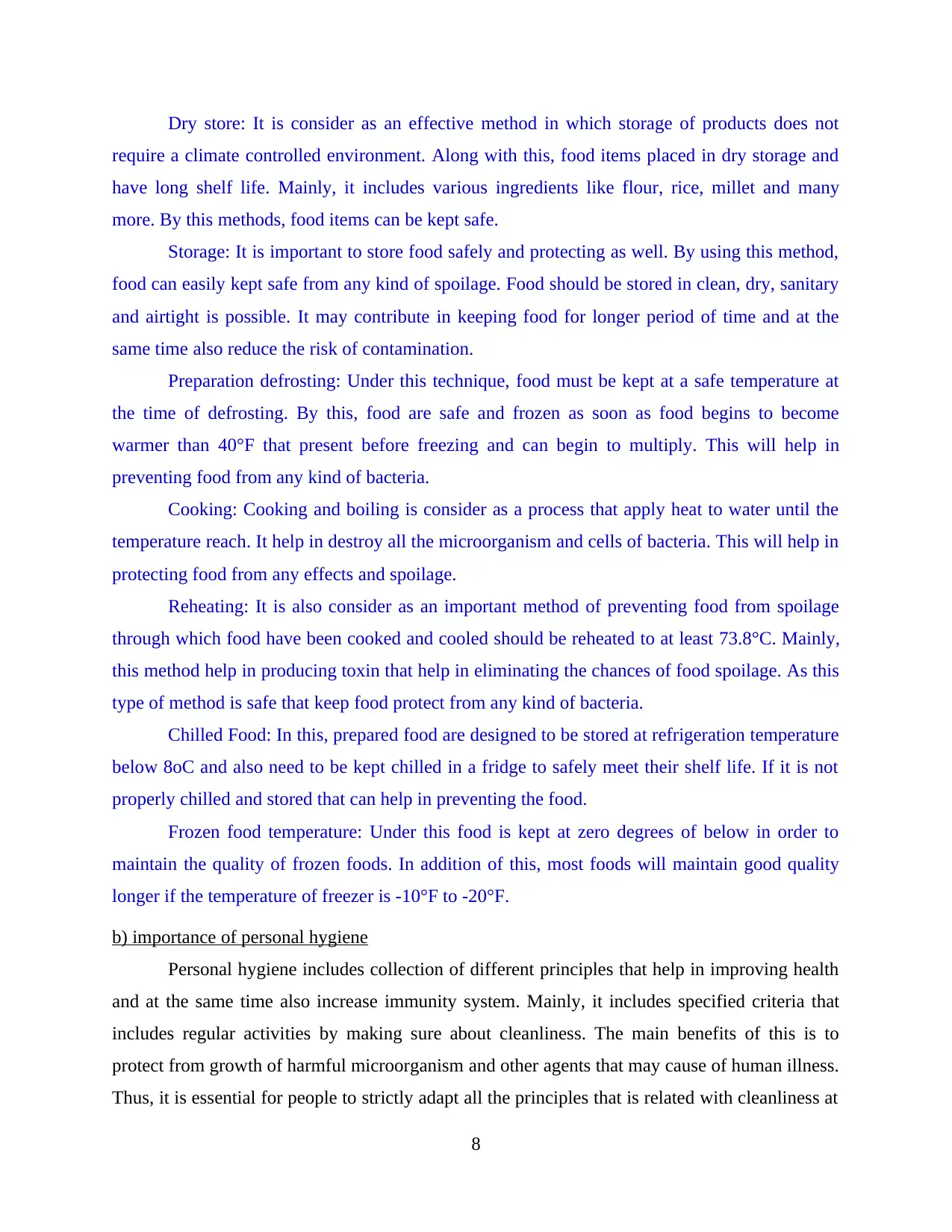
Dry store: It is consider as an effective method in which storage of products does not
require a climate controlled environment. Along with this, food items placed in dry storage and
have long shelf life. Mainly, it includes various ingredients like flour, rice, millet and many
more. By this methods, food items can be kept safe.
Storage: It is important to store food safely and protecting as well. By using this method,
food can easily kept safe from any kind of spoilage. Food should be stored in clean, dry, sanitary
and airtight is possible. It may contribute in keeping food for longer period of time and at the
same time also reduce the risk of contamination.
Preparation defrosting: Under this technique, food must be kept at a safe temperature at
the time of defrosting. By this, food are safe and frozen as soon as food begins to become
warmer than 40°F that present before freezing and can begin to multiply. This will help in
preventing food from any kind of bacteria.
Cooking: Cooking and boiling is consider as a process that apply heat to water until the
temperature reach. It help in destroy all the microorganism and cells of bacteria. This will help in
protecting food from any effects and spoilage.
Reheating: It is also consider as an important method of preventing food from spoilage
through which food have been cooked and cooled should be reheated to at least 73.8°C. Mainly,
this method help in producing toxin that help in eliminating the chances of food spoilage. As this
type of method is safe that keep food protect from any kind of bacteria.
Chilled Food: In this, prepared food are designed to be stored at refrigeration temperature
below 8oC and also need to be kept chilled in a fridge to safely meet their shelf life. If it is not
properly chilled and stored that can help in preventing the food.
Frozen food temperature: Under this food is kept at zero degrees of below in order to
maintain the quality of frozen foods. In addition of this, most foods will maintain good quality
longer if the temperature of freezer is -10°F to -20°F.
b) importance of personal hygiene
Personal hygiene includes collection of different principles that help in improving health
and at the same time also increase immunity system. Mainly, it includes specified criteria that
includes regular activities by making sure about cleanliness. The main benefits of this is to
protect from growth of harmful microorganism and other agents that may cause of human illness.
Thus, it is essential for people to strictly adapt all the principles that is related with cleanliness at
8
require a climate controlled environment. Along with this, food items placed in dry storage and
have long shelf life. Mainly, it includes various ingredients like flour, rice, millet and many
more. By this methods, food items can be kept safe.
Storage: It is important to store food safely and protecting as well. By using this method,
food can easily kept safe from any kind of spoilage. Food should be stored in clean, dry, sanitary
and airtight is possible. It may contribute in keeping food for longer period of time and at the
same time also reduce the risk of contamination.
Preparation defrosting: Under this technique, food must be kept at a safe temperature at
the time of defrosting. By this, food are safe and frozen as soon as food begins to become
warmer than 40°F that present before freezing and can begin to multiply. This will help in
preventing food from any kind of bacteria.
Cooking: Cooking and boiling is consider as a process that apply heat to water until the
temperature reach. It help in destroy all the microorganism and cells of bacteria. This will help in
protecting food from any effects and spoilage.
Reheating: It is also consider as an important method of preventing food from spoilage
through which food have been cooked and cooled should be reheated to at least 73.8°C. Mainly,
this method help in producing toxin that help in eliminating the chances of food spoilage. As this
type of method is safe that keep food protect from any kind of bacteria.
Chilled Food: In this, prepared food are designed to be stored at refrigeration temperature
below 8oC and also need to be kept chilled in a fridge to safely meet their shelf life. If it is not
properly chilled and stored that can help in preventing the food.
Frozen food temperature: Under this food is kept at zero degrees of below in order to
maintain the quality of frozen foods. In addition of this, most foods will maintain good quality
longer if the temperature of freezer is -10°F to -20°F.
b) importance of personal hygiene
Personal hygiene includes collection of different principles that help in improving health
and at the same time also increase immunity system. Mainly, it includes specified criteria that
includes regular activities by making sure about cleanliness. The main benefits of this is to
protect from growth of harmful microorganism and other agents that may cause of human illness.
Thus, it is essential for people to strictly adapt all the principles that is related with cleanliness at
8
Paraphrase This Document
Need a fresh take? Get an instant paraphrase of this document with our AI Paraphraser
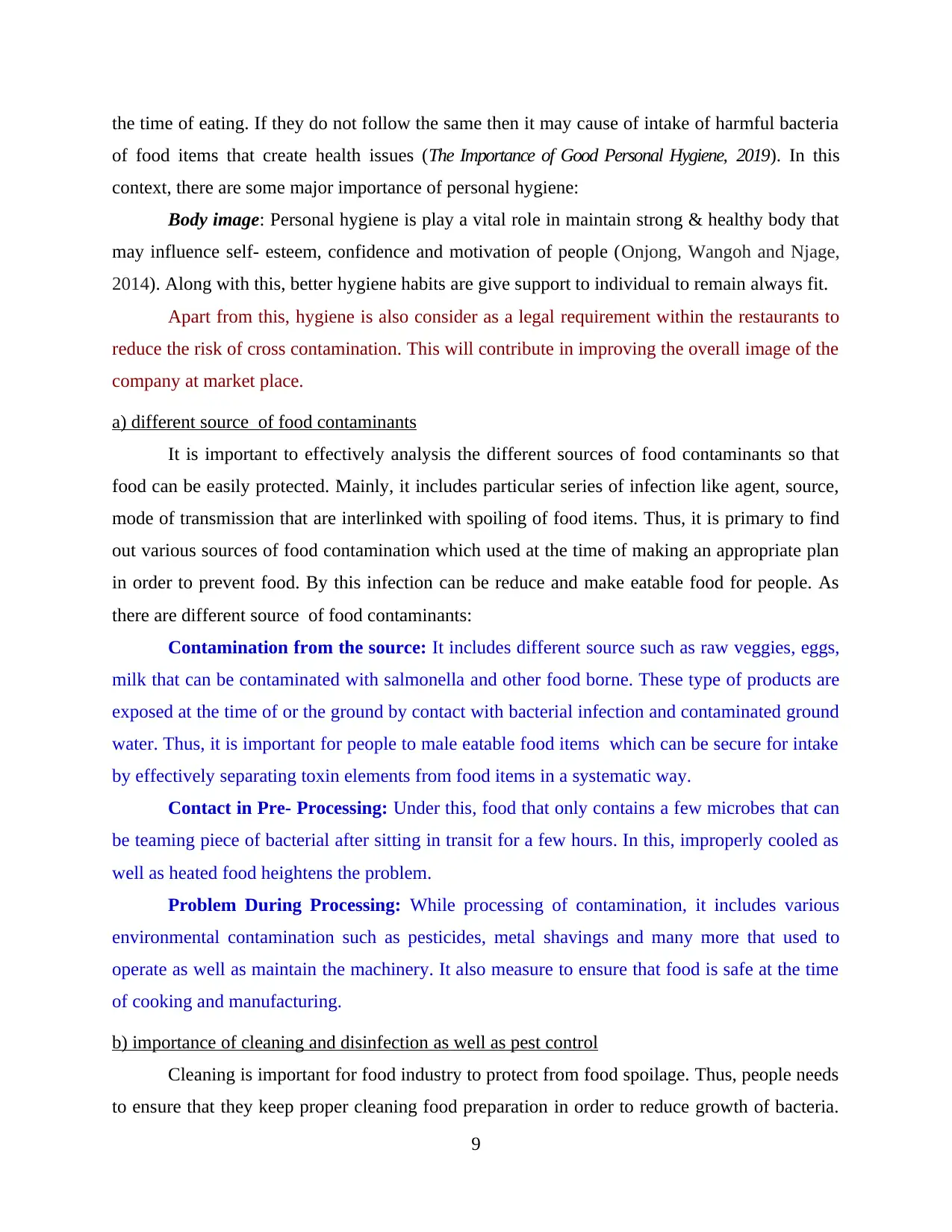
the time of eating. If they do not follow the same then it may cause of intake of harmful bacteria
of food items that create health issues (The Importance of Good Personal Hygiene, 2019). In this
context, there are some major importance of personal hygiene:
Body image: Personal hygiene is play a vital role in maintain strong & healthy body that
may influence self- esteem, confidence and motivation of people (Onjong, Wangoh and Njage,
2014). Along with this, better hygiene habits are give support to individual to remain always fit.
Apart from this, hygiene is also consider as a legal requirement within the restaurants to
reduce the risk of cross contamination. This will contribute in improving the overall image of the
company at market place.
a) different source of food contaminants
It is important to effectively analysis the different sources of food contaminants so that
food can be easily protected. Mainly, it includes particular series of infection like agent, source,
mode of transmission that are interlinked with spoiling of food items. Thus, it is primary to find
out various sources of food contamination which used at the time of making an appropriate plan
in order to prevent food. By this infection can be reduce and make eatable food for people. As
there are different source of food contaminants:
Contamination from the source: It includes different source such as raw veggies, eggs,
milk that can be contaminated with salmonella and other food borne. These type of products are
exposed at the time of or the ground by contact with bacterial infection and contaminated ground
water. Thus, it is important for people to male eatable food items which can be secure for intake
by effectively separating toxin elements from food items in a systematic way.
Contact in Pre- Processing: Under this, food that only contains a few microbes that can
be teaming piece of bacterial after sitting in transit for a few hours. In this, improperly cooled as
well as heated food heightens the problem.
Problem During Processing: While processing of contamination, it includes various
environmental contamination such as pesticides, metal shavings and many more that used to
operate as well as maintain the machinery. It also measure to ensure that food is safe at the time
of cooking and manufacturing.
b) importance of cleaning and disinfection as well as pest control
Cleaning is important for food industry to protect from food spoilage. Thus, people needs
to ensure that they keep proper cleaning food preparation in order to reduce growth of bacteria.
9
of food items that create health issues (The Importance of Good Personal Hygiene, 2019). In this
context, there are some major importance of personal hygiene:
Body image: Personal hygiene is play a vital role in maintain strong & healthy body that
may influence self- esteem, confidence and motivation of people (Onjong, Wangoh and Njage,
2014). Along with this, better hygiene habits are give support to individual to remain always fit.
Apart from this, hygiene is also consider as a legal requirement within the restaurants to
reduce the risk of cross contamination. This will contribute in improving the overall image of the
company at market place.
a) different source of food contaminants
It is important to effectively analysis the different sources of food contaminants so that
food can be easily protected. Mainly, it includes particular series of infection like agent, source,
mode of transmission that are interlinked with spoiling of food items. Thus, it is primary to find
out various sources of food contamination which used at the time of making an appropriate plan
in order to prevent food. By this infection can be reduce and make eatable food for people. As
there are different source of food contaminants:
Contamination from the source: It includes different source such as raw veggies, eggs,
milk that can be contaminated with salmonella and other food borne. These type of products are
exposed at the time of or the ground by contact with bacterial infection and contaminated ground
water. Thus, it is important for people to male eatable food items which can be secure for intake
by effectively separating toxin elements from food items in a systematic way.
Contact in Pre- Processing: Under this, food that only contains a few microbes that can
be teaming piece of bacterial after sitting in transit for a few hours. In this, improperly cooled as
well as heated food heightens the problem.
Problem During Processing: While processing of contamination, it includes various
environmental contamination such as pesticides, metal shavings and many more that used to
operate as well as maintain the machinery. It also measure to ensure that food is safe at the time
of cooking and manufacturing.
b) importance of cleaning and disinfection as well as pest control
Cleaning is important for food industry to protect from food spoilage. Thus, people needs
to ensure that they keep proper cleaning food preparation in order to reduce growth of bacteria.
9
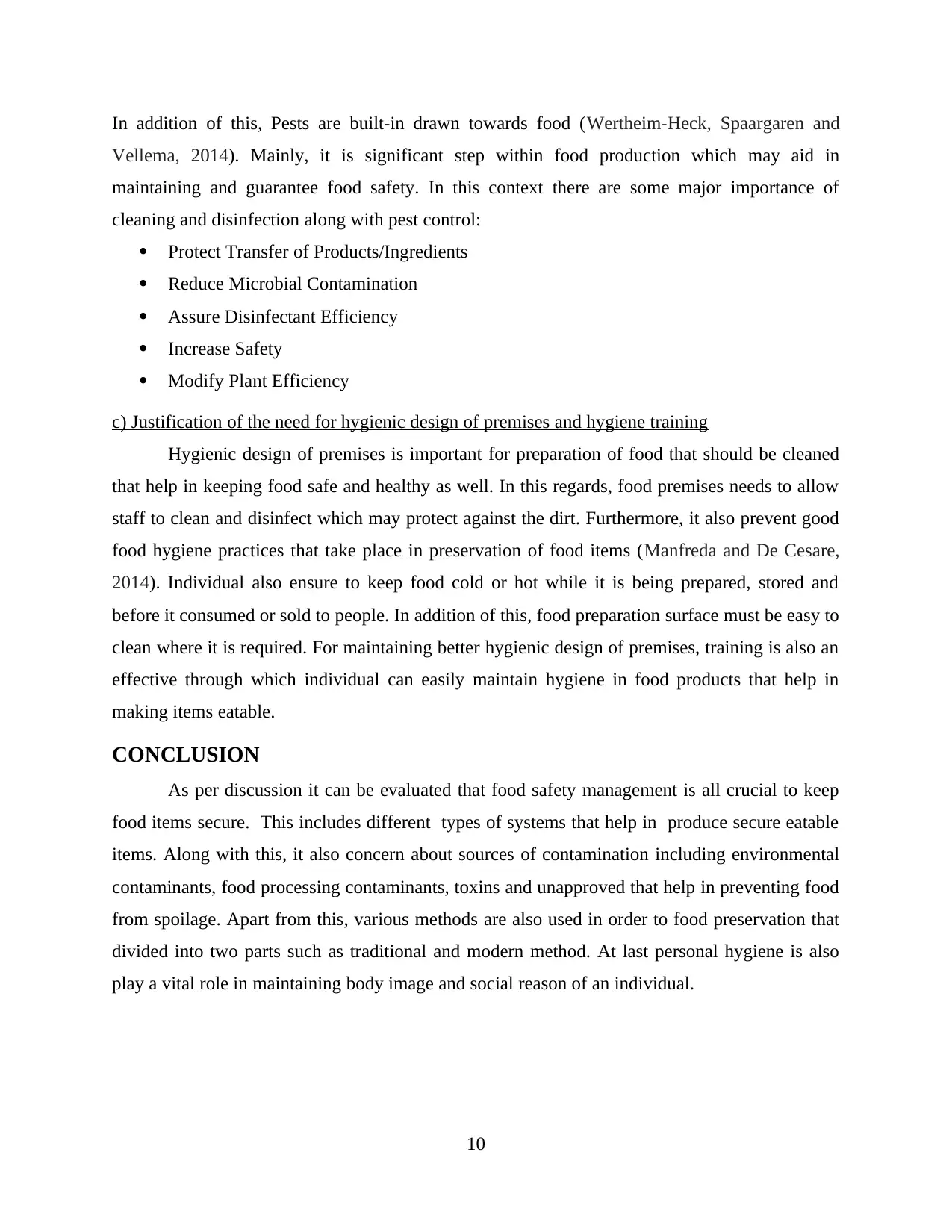
In addition of this, Pests are built-in drawn towards food (Wertheim-Heck, Spaargaren and
Vellema, 2014). Mainly, it is significant step within food production which may aid in
maintaining and guarantee food safety. In this context there are some major importance of
cleaning and disinfection along with pest control:
Protect Transfer of Products/Ingredients
Reduce Microbial Contamination
Assure Disinfectant Efficiency
Increase Safety
Modify Plant Efficiency
c) Justification of the need for hygienic design of premises and hygiene training
Hygienic design of premises is important for preparation of food that should be cleaned
that help in keeping food safe and healthy as well. In this regards, food premises needs to allow
staff to clean and disinfect which may protect against the dirt. Furthermore, it also prevent good
food hygiene practices that take place in preservation of food items (Manfreda and De Cesare,
2014). Individual also ensure to keep food cold or hot while it is being prepared, stored and
before it consumed or sold to people. In addition of this, food preparation surface must be easy to
clean where it is required. For maintaining better hygienic design of premises, training is also an
effective through which individual can easily maintain hygiene in food products that help in
making items eatable.
CONCLUSION
As per discussion it can be evaluated that food safety management is all crucial to keep
food items secure. This includes different types of systems that help in produce secure eatable
items. Along with this, it also concern about sources of contamination including environmental
contaminants, food processing contaminants, toxins and unapproved that help in preventing food
from spoilage. Apart from this, various methods are also used in order to food preservation that
divided into two parts such as traditional and modern method. At last personal hygiene is also
play a vital role in maintaining body image and social reason of an individual.
10
Vellema, 2014). Mainly, it is significant step within food production which may aid in
maintaining and guarantee food safety. In this context there are some major importance of
cleaning and disinfection along with pest control:
Protect Transfer of Products/Ingredients
Reduce Microbial Contamination
Assure Disinfectant Efficiency
Increase Safety
Modify Plant Efficiency
c) Justification of the need for hygienic design of premises and hygiene training
Hygienic design of premises is important for preparation of food that should be cleaned
that help in keeping food safe and healthy as well. In this regards, food premises needs to allow
staff to clean and disinfect which may protect against the dirt. Furthermore, it also prevent good
food hygiene practices that take place in preservation of food items (Manfreda and De Cesare,
2014). Individual also ensure to keep food cold or hot while it is being prepared, stored and
before it consumed or sold to people. In addition of this, food preparation surface must be easy to
clean where it is required. For maintaining better hygienic design of premises, training is also an
effective through which individual can easily maintain hygiene in food products that help in
making items eatable.
CONCLUSION
As per discussion it can be evaluated that food safety management is all crucial to keep
food items secure. This includes different types of systems that help in produce secure eatable
items. Along with this, it also concern about sources of contamination including environmental
contaminants, food processing contaminants, toxins and unapproved that help in preventing food
from spoilage. Apart from this, various methods are also used in order to food preservation that
divided into two parts such as traditional and modern method. At last personal hygiene is also
play a vital role in maintaining body image and social reason of an individual.
10
⊘ This is a preview!⊘
Do you want full access?
Subscribe today to unlock all pages.

Trusted by 1+ million students worldwide
1 out of 14
Related Documents
Your All-in-One AI-Powered Toolkit for Academic Success.
+13062052269
info@desklib.com
Available 24*7 on WhatsApp / Email
![[object Object]](/_next/static/media/star-bottom.7253800d.svg)
Unlock your academic potential
Copyright © 2020–2025 A2Z Services. All Rights Reserved. Developed and managed by ZUCOL.





